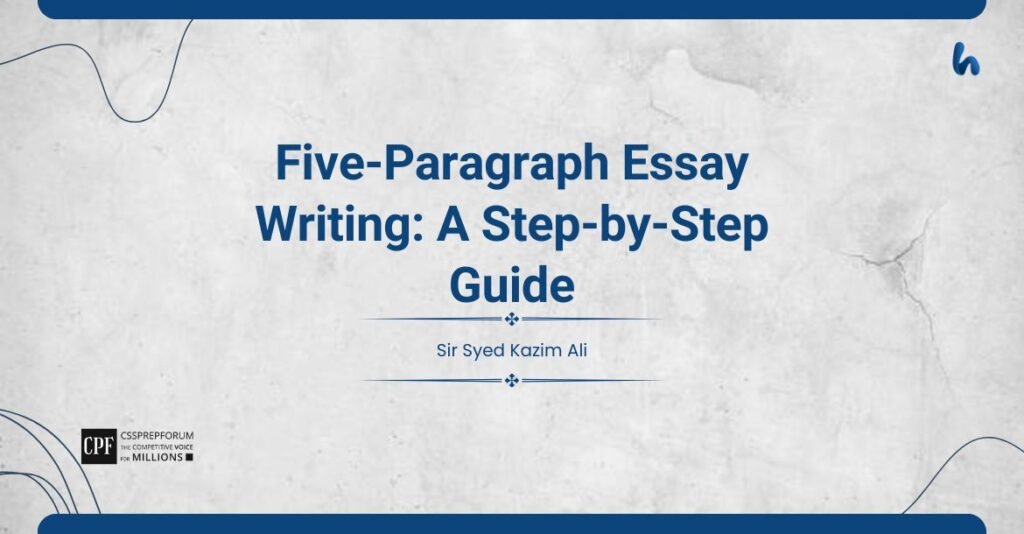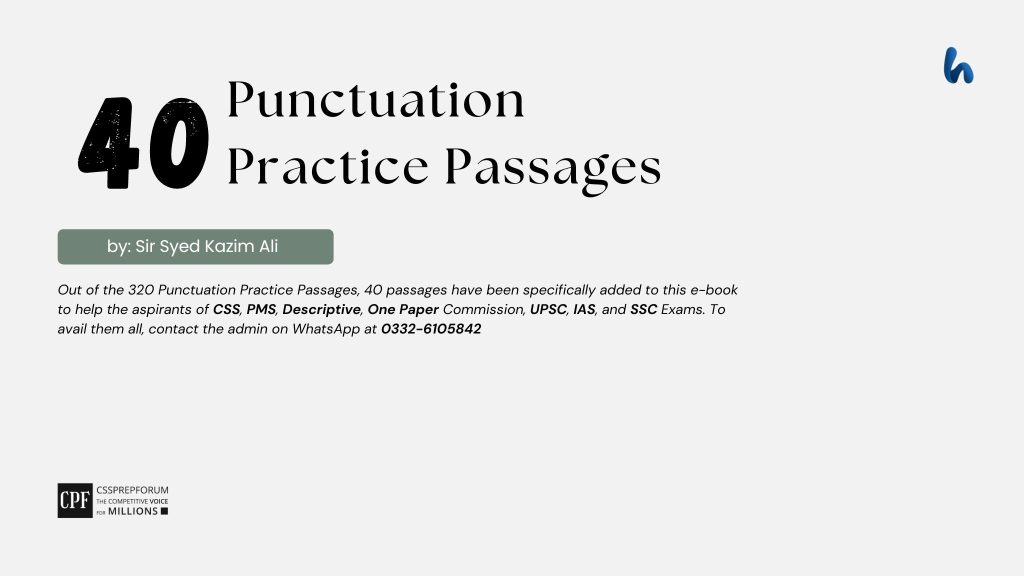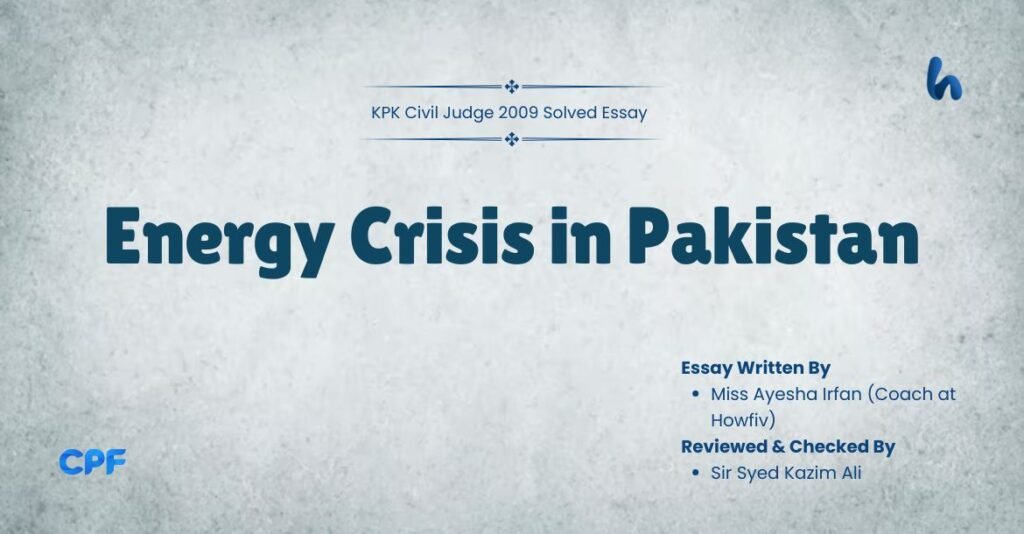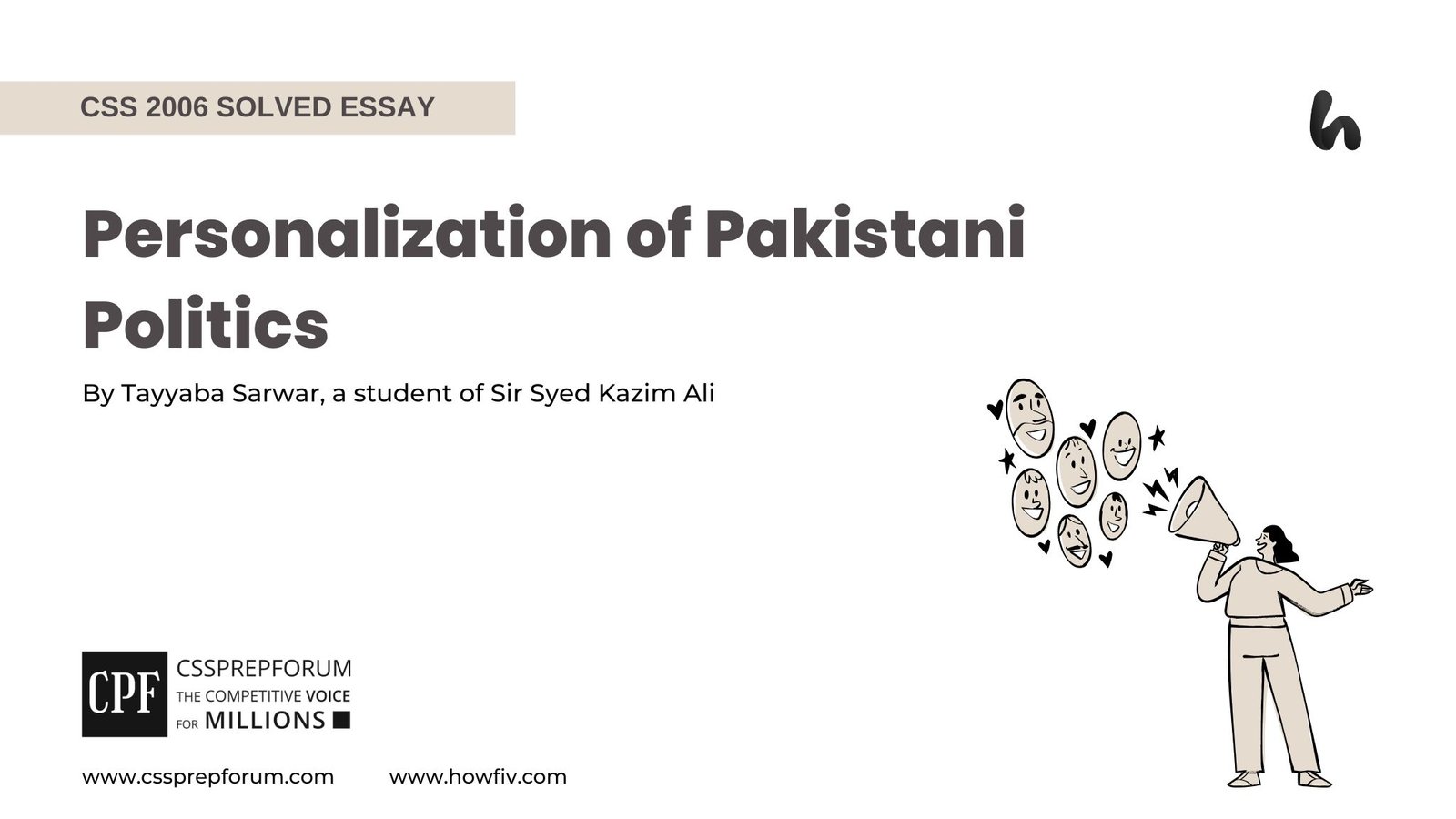Miss Ayesha Irfan, a Sir Syed Kazim Ali student, has attempted the Civil Judge KPK 2009 Five Paragraph Essay “Energy Crisis in Pakistan“ on the given pattern, which Sir Syed Kazim Ali teaches his students. Sir Syed Kazim Ali has been Pakistan’s top English writing and CSS, PMS essay and precis coach with the highest success rate of his students. The essay is uploaded to help other judiciary and competitive aspirants learn and practice essay writing techniques and patterns to qualify for the essay paper.

Energy Crisis in Pakistan
Outline
1-Introduction
Pakistan’s energy crisis, driven by supply-demand gaps, reliance on fossil fuels, and inefficient infrastructure, has crippled industries, slowed economic growth, and disrupted daily life, but adopting renewable energy, modernizing infrastructure, and implementing policy reforms can offer sustainable solutions.
2-Causes of the Energy Crisis in Pakistan
- The crisis is primarily driven by supply-demand imbalances, dependence on expensive fuel imports, and transmission losses.
- Evidence: Pakistan’s electricity demand is around 30,000 MW, while production fluctuates between 20,000-25,000 MW, causing frequent shortages (National Energy Report, 2023).
3-Impacts of the Energy Crisis on Economy and Society
- Power shortages have crippled industries, increased unemployment, and slowed economic growth, affecting millions.
- Evidence: Pakistan loses 2-3% of its GDP annually due to power outages, reducing industrial output and foreign investment (World Bank, 2022).
4-Sustainable Solutions to the Energy Crisis
- Investing in renewable energy, modernizing infrastructure, and enforcing policy reforms can provide long-term relief.
- Evidence: Pakistan has a renewable energy potential of 50,000 MW from wind and 2.9 million MW from solar, yet renewables contribute only 6% to the national grid (Alternative Energy Development Board, 2022).
5-Conclusion

The Essay Begins Below!
Pakistan is facing a severe energy crisis that threatens economic stability, industrial productivity, and the daily lives of millions. With electricity shortfalls reaching 5,000-7,000 Mega Watt during peak seasons, businesses and households experience prolonged power outages, leading to widespread disruptions. The country’s overreliance on imported fossil fuels, outdated infrastructure, and inefficient energy policies have worsened the situation. According to the World Bank (2022), Pakistan loses 2-3% of its GDP annually due to power shortages, highlighting the urgent need for reform. This crisis has far-reaching economic and social consequences, but investing in renewable energy, upgrading infrastructure, and implementing strong policies can provide long-term solutions. Addressing these challenges is essential for Pakistan’s sustainable development and energy security.
The energy crisis in Pakistan is primarily driven by several interrelated factors, including supply-demand imbalances, reliance on costly fossil fuels, and outdated infrastructure. As highlighted in the National Energy Report of 2023, the country’s electricity demand has surged to approximately 30,000 MW, whereas production hovers between 20,000 and 25,000 MW. This discrepancy has resulted in a significant shortfall, leading to frequent power outages that affect daily life and economic activities. Compounding this issue, over 60% of Pakistan’s electricity is generated from imported fossil fuels, which exposes the nation to the volatility of global energy prices, as reported by the Ministry of Energy in 2023. An increase in fuel prices directly escalates electricity costs, imposing a substantial financial strain on both households and businesses. Furthermore, according to the National Transmission & Dispatch Company, in 2023, the country suffered additional losses of up to 17% of generated electricity due to outdated transmission lines and widespread power theft, further exacerbating the existing energy crisis.
As a result of these energy shortages, Pakistan’s economy and society face severe consequences, including industrial decline, rising unemployment, and slowed economic growth. The World Bank (2022) estimates that Pakistan loses 2-3% of its GDP annually due to power outages, which disrupt industrial productivity and discourage foreign investment. The crisis has particularly affected the textile industry, Pakistan’s largest export sector. According to the Pakistan Economic Survey (2023), textile exports have declined by 15% due to prolonged power shortages, leading to factory closures and job losses. Moreover, frequent power cuts disrupt small businesses, schools, and hospitals, making daily life increasingly difficult. Rising electricity costs contribute to inflation as manufacturers pass on higher production expenses to consumers. If the crisis persists, poverty levels will rise, and economic instability will deepen, further straining Pakistan’s fragile economy.
Given these challenges, Pakistan must take urgent steps to address the energy crisis through renewable energy investment, infrastructure modernization, and policy reforms. Fortunately, the country has enormous untapped energy resources. Pakistan has a renewable energy potential of 50,000 MW from wind and 2.9 million MW from solar, yet these sources currently contribute only 6% to the national grid (Alternative Energy Development Board, 2022). Expanding solar and wind energy can reduce reliance on expensive fuel imports and create a more sustainable electricity supply. Additionally, modernizing transmission lines can reduce power losses by 30%, ensuring that more generated electricity reaches consumers efficiently (International Energy Agency, 2022). Finally, implementing energy conservation policies, offering investment incentives, and enforcing regulatory reforms will help stabilize the energy sector. If these solutions are prioritized, Pakistan can overcome its energy deficit, attract investment, and pave the way for long-term economic growth.
In conclusion, Pakistan’s energy crisis is a major national challenge driven by supply-demand imbalances, reliance on imported fossil fuels, and outdated infrastructure. This crisis has weakened the economy, reduced industrial productivity, increased unemployment, and disrupted essential services. With Pakistan losing 2-3% of its GDP annually due to power shortages and industries suffering from severe setbacks, the need for urgent action is clear. Additionally, frequent power outages in hospitals and schools have negatively impacted public health and education. If left unaddressed, the crisis will further destabilize the country. Therefore, tackling this issue is essential for Pakistan’s economic stability, social well-being, and long-term development.

Click on Any to Start Reading



FAQs About Sir Syed Kazim Ali

CSS Solved Past Papers’ Essays
Looking for the last ten years of CSS and PMS Solved Essays and want to know how Sir Kazim’s students write and score the highest marks in the essays’ papers? Then, click on the CSS Solved Essays to start reading them.
CSS Solved Essays
CSS Solved General Science & Ability Past Papers
Want to read the last ten years’ General Science & Ability Solved Past Papers to learn how to attempt them and to score high? Let’s click on the link below to read them all freely. All past papers have been solved by Miss Iqra Ali & Dr Nishat Baloch, Pakistan’s top CSS GSA coach having the highest score of their students. General Science & Ability Solved Past Papers












